Scripture Notes Old
Testament
p a g e
4
-Unicorn: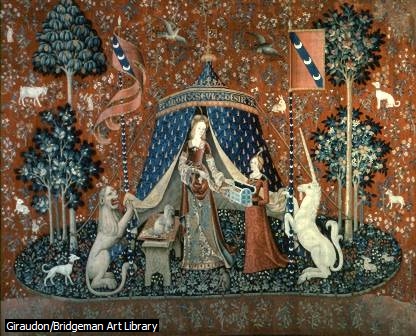
Barnes
Notes: The idea here is, that he cried to God when exposed to what
is here called "the horns of the unicorns":.Psalms
22:21 "Save me from the lion's mouth, for you have heard me from the
horns of the unicorns.".That
is, when surrounded by enemies as fierce and violent as wild beasts, as
if he were among 'unicorns' seeking his life. Here he called upon God and
God had heard him. This would refer to some former period of his life,
when surrounded by dangers or exposed to the attacks of wicked men and
when he had called upon God and had been heard.
Picture information:.The
Lady and the Unicorn,.circa
1515, from The Hunt of the Unicorn, is one of a series of Franco-Flemish
tapestries. Woven of silk and wool with silver threads, they are remarkable
for their profusion of realistic detail. The top of the tent reads "To
my only desire". From Giraudon/Bridgeman Art Library. Unicorns are depicted
in a cave in Lascaux, France. The number of figures represented in cave
paintings ranges from a few in some caves to several hundred in caves such
as Lascaux or Les Trois Frères, also in France.....Microsoft®
Encarta® Encyclopedia 99. © 1993-1998 Microsoft Corporation. All
rights reserved.
There were not a few occasions
alike in the life of David and in the life of the Saviour, to which this
would be applicable. The fact that he had thus been delivered from danger,
is now urged as an argument why the Creator was to be regarded as able
to deliver him again and why the prayer might be offered that he would
do it:.Psalms
22:9-11.
The existence
of such an animal was long regarded as astonishing
and barely.credible.
However,
it has been proved that there is such an animal, as explained below. The
word unicorn occurs elsewhere:.Numbers
23:22; 24:8; Deuteronomy
33:17; Psalms 22:21; 29:6;
92:10;
Isaiah
34:7.
There was some special majesty
or dignity in the horns of this animal that attracted attention and that
made them the proper symbol of dominion and of royal authority as Psalms
92:10 shows.
Evidences of the unicorn's
existence have been confirmed. These evidences are adduced
by Rosenmuller, Morgenland, ii. p. 269, following and by Prof. Robinson,
Calmet, pp. 908,909. They are, summarily,
the following:
(1) Pliny.(Roman
writer and encyclopedist, who was the foremost authority on science in
ancient Europe; wrote Historia Naturalis.encyclopedia
of nature and art in 37 books).mentions
such an animal {8,21} and gives a description of it, though from his time
for centuries it seems to have been unknown. His language is, 'Asperrimam
autem feram monocerotem reliquo corpore equo similem, capite cervo, pedibus
elephanti, cauda apro, mugitu gravi, uno cornu nigro media fronte cubitorum
duum eminente. IIanc feram vivam negant capi', meaning "The unicorn is
an exceeding fierce animal, resembling a horse as to the rest of his body,
but having the head like a stag.(adult
deer), the feet like an elephant and
the tail like a wild boar.(a
wild pig). Its roaring is loud and
it has a black horn of about two cubits
projecting from the middle of the forehead."
(2) The figure of the unicorn, in various attitudes,
according to Niebuhr, is depicted
on almost all the staircases in the ruins of Persepolis.(an
ancient city of Persia northeast
of modern Shiraz in southwest Iran).....Reisebeschreib.
ii. S. 127.
northeast
of modern Shiraz in southwest Iran).....Reisebeschreib.
ii. S. 127.
In 1530, Ludovice de Bartema,
a Roman patrician, visited Mecca
under the assumed character of a Mussulman.(a
Moslem).and
among other curiosities that he mentions, he says "On
the other side of the Kaaba.(An
English linear measure equal to 45 inches {114 centimeters} a Moslem shrine
in Mecca toward which the faithful turn to pray).is
a walled court in which we saw two unicorns that were pointed out to us
as a rarity and they are indeed truly remarkable. The larger of the two
is built like a three-year-old colt and has a horn upon the forehead about
three ells.(an
English linear measure equal to 45 inches {114 centimeters}).long.
This animal has the color of a yellowish-brown horse, a head like a stag.(adult
deer), a neck not very long with a
thin mane; the legs are small and slender like those of a hind
or roe.(small
deer, 28" at shoulder); the forefoot
hoofs are divided and resemble the hoofs of a goat."
...Rosenmuller. Alte u. neue Morgenland, No. 377. Thessalonians ii. S.
271, 272.
(4) Don Juan Gabriel, a Portuguese colonel, who lived several years in
Abyssinia.(ancient
Ethiopia), assures us that in the region
of Agamos, in the Abyssinian province of Darners, he had seen an animal
of the form and size of a middle-sized horse, of a dark, chestnut-brown
color and with a whitish horn about five spans.(9
inches {23 centimeters}).long
upon its forehead. The mane and tail were black and the legs long and slender.
Several other Portuguese, who were placed in confinement upon a high mountain
in the district Namna, by the Abyssinian king Saghedo, related that they
had seen at the mountain several unicorns feeding. These accounts are confirmed
by Lobe, who lived for a long time as a missionary in Abyssinia.
(5) Dr. Sparrman the Swedish naturalist, who visited the Cape of Good Hope
and the adjacent regions in 1772-1776, gives, in his Travels, the
following account."Jacob
Kock an observing peasant on Hippopotamus river, who had traveled over
a considerable part of Southern Africa, found on the face of a perpendicular
rock, a drawing made by the Hotttentots.(pastoral
{shepherds or herders} people of Namibia and South Africa).of
an animal with a single horn. The Hottentots told him that the animal there
represented was very like the horse on which he rode, but had a straight
horn upon the forehead. They added, that these one-horned animals were
rare, that they ran with great rapidity and that they were very fierce."
(6) A similar animal is described as having been killed by a party of Hottentots
in pursuit of the savage Bushmen in 1791.."The
animal resembled a horse, was of a light grey color and with white stripes
under the jaw. It had a single horn directly in front, as long as one's
arm and at the base about as thick. Toward the middle the horn was somewhat
flattened but had a sharp point. It was not attached to the bone of the
forehead, but was fixed only in the skin. The head was like that of the
horse and the size about the same." ...Rosenmuller,
Alte u. nerve Morgenland, vol. ii. p. 269ff, ed. Leipz. 1818.
(7) To these proofs one other is added by Prof. Robinson. It is copied
from the Quarterly Review for Oct. 1820, vol. xxiv. p. 120, in a
notice of Frazer's Tour through the Himalaya mountains. The information
is contained in a letter from Major Latter, commanding in the rajah of
Sikkim's territories, in the hilly country east of Nepal. This letter states
that."the unicorn
animal, so long considered as an astonishment, actually exists in the interior
of Tibet, where it is well known to the inhabitants. In a Tibetan manuscript
says Major Latter, containing the names of different animals, which I procured
the other day from the hills, the unicorn is classed under the head of
those whose hoofs are divided. It is called the one-horned tso'po.
"Upon inquiring what kind
of an animal it was, to our astonishment, the person who brought the manuscript
described exactly the unicorn of the ancients, saying that it was a native
of the interior of Tibet, about the size of a tattoo.(a
horse from twelve to thirteen hands {a hand was 4 inches or 10.2 centimeters}
high), fierce and extremely wild and
seldom if ever caught alive, but frequently shot and that the flesh was
used for food. They go together in herds, like wild buffalo and are frequently
to be met with on the borders of the great desert, in that part of the
country inhabited by wandering Tartars."
(8) To these proofs I add another, taken from the Narrative of the Rev.
John Campbell, who thus speaks of it, in his Travels in South Africa,
vol. ii. p. 294.."While
in the Mashow territory, the Hottentots brought in a head different from
any rhinoceros that had been previously killed. The common African rhinoceros
has a crooked horn resembling a cock's.(an
adult male chicken, called a rooster).spur,
which rises about nine or ten inches above the nose and inclines backward.
Immediately behind this is a short thick horn. But the head they brought
us had a straight horn projecting three feet from the forehead, about ten
inches above the tip of the nose. The projection of this great horn very
much resembles that of the fanciful unicorn in the British arms. It has
a small, thick, horny substance, eight inches long, immediately behind
it and which can hardly be observed on the animal at the distance of 100
yards and seems to be designed for keeping fast that which is penetrated
by the long horn. The head resembled in size a nine-gallon cask and measured
three feet from the mouth to the ear. From its weight and the position
of the horn, it appears capable of overcoming any creature hitherto known."
A fragment of the skull,
with the horn, is deposited in the Museum
of the London Missionary Society. These testimonies from so many witnesses
from different parts of the world, who write without concert
and yet who concur
so almost entirely in the account of the size and figure of the animal,
leave little room to doubt its real existence. That it is not better known
and that its existence has been doubted, is not wonderful. It is to be
remembered that all accounts agree in the representation that it is an
animal whose residence is in deserts or mountains and that large parts
of Africa and Asia are still unexplored.
We are to remember also,
that the giraffe has been discovered only some few years ago and that the same is true of the gnu.(wildebeest),
which until recently was held to be a fable of the ancients. At the same
time, however, that the existence of such an animal as that of the unicorn
is in the highest degree probable.
only some few years ago and that the same is true of the gnu.(wildebeest),
which until recently was held to be a fable of the ancients. At the same
time, however, that the existence of such an animal as that of the unicorn
is in the highest degree probable.
Some have thought that the
animal referred to was a rhinoceros.
The unicorn was obviously
an animal well known to the Hebrews, being everywhere mentioned with other
animals common to the country, while the rhinoceros was never an inhabitant
of the country, is nowhere else spoken of by the sacred writers, nor, according
to Bochart, either by Aristotle
in his treatise
of animals, nor by Arabian writers. It does not seem therefore to admit
of reasonable doubt that the rhinoceros is referred to in the passage before
us.
Notes on Ezekiel
14:9:
Barnes
Notes:."A
deep truth lies beneath these words, namely, that evil as well as good
is under Godís direction. He turns it as He will, employing it to test
the sincerity of men and thus making it ultimately contribute to the purification
of His people, to the confirmation of the righteous, to the increase of
their glory and felicity.
The case of the false prophets.(*).who
deceived Ahab.(1Kings
22:20-22).is
a striking representation of this principle. The Lord sends forth an evil
spirit to persuade Ahab to his ruin. Toward the close of the kingdom of
Judah false prophets were especially rife.
The thoughts of men's hearts were revealed, the good separated from the
bad and the remnant of the people purged from the sins by which of late
years the whole nation had been defiled."
Adam
Clarke's Commentary:."That
is, he ran before he was sent; he willingly became the servant of Satan's
illusions and I suffered this to take place, because he and his followers
refused to consult and serve me. It is common in the Hebrew language to
state a thing as done by the Lord which he only suffers or permits to be
done, for so absolute and universal is the government of God, that the
smallest occurrence cannot take place without his will or permission."
Eclectic
Notes:."As
we learned in the previous prophetic message that such deceiving prophets
were in abundance among Israel. They were the curse of the nation. Little
did they care about the spiritual condition of the people. They prophesied
for filthy lucre's.(money).sake
and lived in sin like the rest of the apostates.
To them people came to inquire of the Lord and the deceiving prophets prophesied
smooth things.(Isaiah
30:9,10). But the Lord Himself
as a judgment had deceived their prophets to ripen the people for the deserved
doom. It is the same what Micaiah
declared in the presence of King
Jehoshaphat and King
Ahab. The four hundred prophets of Ahab were possessed by a lying spirit."
Matthew
Henry's Concise Commentary:."No
outward form or reformation can be acceptable to God as long as any idol
possesses the heart, yet how many prefer their own devices and their
own righteousness, to the way of salvation. Men's corruptions are idols
in their hearts and are of their own setting up. God will let them take
their course.".Hosea
4:17 "Ephraim is joined to idols; let him alone."
Matthew
Poole's Commentary:."The
prophet who makes this his trade and gain, the false
prophet, who speaks all serene and quiet, in hope of reward for his
kind answer to those that desired to hear what might please them more than
what God commanded, promised or threatened."
Times don't change people,
yet people do change. But as any recovered alcoholic or drug addict can
tell you, it's work where one needs the help of the true God. The circumstances
they are in bring forth attitudes today as they did in ancient times. The
same consciousness causes the same issues.(*),
the consciousness that is easily
pumped by the beings of the dark side. The
history.
The corrupted 'wisdom' of
those having concocted methods for use in depopulating the world, the eradication
of all humans, yes even
them as it has been designed to be by the master
duper.
But, one can decide against
the negatives:.Ephesians
6:12 "For we wrestle not against flesh and blood, but against principalities,
against powers, against the rulers of the darkness of this world, against
spiritual wickedness in high places." Isaiah
10:1,2 "Woe unto them that decree unrighteous decrees and that write
grievousness which they have prescribed to turn aside the needy from judgment
and to take away the right from the poor of my people, that widows may
be their prey and that they may rob the fatherless!" Job
13:4 "But you are forgers of lies...".Matthew
23:13-33. The people influenced by the dark side, care not at all
for others, though they may appear as if they do:.Matthew
7:15,16. They have been deceived and of course don't know that they
have been:.Isaiah
30:1-18; Revelation 12:9.
Once men and women today
change the consciousness of the world.(how?),
the history of negatives causing hurts in so many ways will be all a thing
of the past.
In the time of Moses,
look
what happened dealing with the leaders of ancient Egypt.
The Egyptians back then thought
as some have today, considering themselves as being above others who they
cared not to get to know and instead thinking that others not of their
ilk
are below them as humans. And they were because many of the far ancient
Pharaohs were not of human descent.
They had strange elongated
heads and were much, much larger in stature.
They implemented
oppressive ways. Ways such as depopulating
those they.deemed
should be, were designed in order to 'keep them as a group in line'.(covid
masks, distancing, etc. of today):.Exodus
1:8-10. Yet Egypt is predicted to be one of the top spiritual nations,
along with those of Assyria
and those called Israelites
once peace reigns on the Earth:.Isaiah
19:20-25.
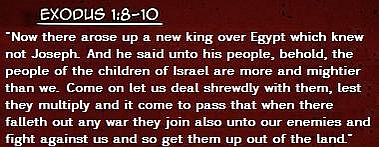
There were many different Pharaohs over Egypt
at different times. A pharaoh simply means a ruler, like a king, a czar,
a prime minister, etc. Pharaohs have existed for ages before they started
to be mentioned in our time. You can tell who they may be by how they are
and what they do. The purposely limit, corrupt and hid historical records,
even changing names of countries to sever connections with true history:.1Kings
10:12.
American
Tract Society Bible Dictionary:."Of
the kings of Egypt.(called
pharaohs),
there are not less than twelve or thirteen mentioned in Scripture, all
of whom bore the general title of Pharaoh, except four. Along with this
title, two of them have also other proper names, Necho
and Hophra. The following
is their order. Some of them have been identified, by the labors of Champollion
and others, with kings whose proper names we know from other sources, while
others still remain in obscurity. Indeed, so brief, obscure and conflicting
are the details of Egyptian history and ancient chronology, which no name
before that of Shishak can be regarded as identified beyond dispute."
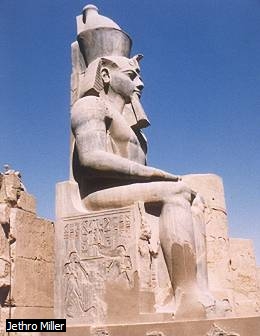
1. Pharaoh, in the time
of Abraham, B.C. or B.C.E.
1920:.Genesis
12:9-20, This pharaoh, whose name is not known, was of the Theban Dynasty
of kings B.C.E. 2755-2255. Thebes,
the ancient capital of Egypt, was the site of the Luxor Temple, shown here.
It was also the site of the tombs for the pharaohs, known as the Valley
of the Kings. The contemporary city of Luxor, on the east bank of the Nile
River, occupies part of the site of ancient Thebes.....comprised
with Microsoft® Encarta® Encyclopedia 99. © 1993-1998 Microsoft
Corporation. All rights reserved.
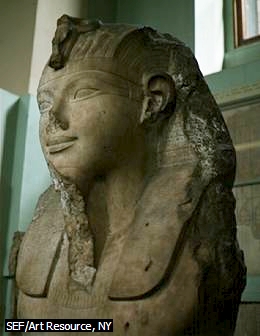 2.
Pharaoh, the master of
Joseph,.Genesis
37:36; Acts 7:10,13, B.C.E
1728. Under this Pharaoh who was kind to Joseph and his family, Joseph
saves all Egypt from famine:.Genesis
47:1-29. Pharaoh gives Joseph a woman named Asenath from whom came
sons named Ephraim and Manasseh:.Genesis
41:45.
2.
Pharaoh, the master of
Joseph,.Genesis
37:36; Acts 7:10,13, B.C.E
1728. Under this Pharaoh who was kind to Joseph and his family, Joseph
saves all Egypt from famine:.Genesis
47:1-29. Pharaoh gives Joseph a woman named Asenath from whom came
sons named Ephraim and Manasseh:.Genesis
41:45.
3. The Pharaoh who knew
not Joseph, B.C. / B.C.E.
1571,.Exodus
1:8-22. During the time of this pharaoh
Moses
was born.
4. Pharaoh, in the time
of Moses:.Exodus
1:8-22; 2:11-15; Acts
7:22,23. Very probably there was another Pharaoh reigning at the time
when Moses fled into Midian and this pharaoh died before Moses did. Moses
at the age of eighty returned from Midian into Egypt:.Exodus
4:19.
5. Pharaoh Amenemhet III.."This
granite statue of Amenemhet III is in a collection at the British Museum
in London. Amenemhet III ruled as king of Egypt from
B.C.E
1842 to 1797, during Egypt's 12th Dynasty. He built a system of irrigation
that increased mineral production and agriculture."....Microsoft®
Encarta® Encyclopedia 99. © 1993-1998 Microsoft Corporation. All
rights reserved.
Jacob and his group were treated congenially
by this pharaoh who had a warm welcome:.Genesis
47:1-27.
6. Pharaoh of the oppression
of the Israelites; their bondage in Egypt:.Isaiah
52:4..Easton's
Bible Dictionary: "Rameses II,
the son of Seti I., is probably the Pharaoh of the Oppression. During his
forty years residence at the court of Egypt, Moses must have known this
ruler well. During his sojourn in Midian, however, Rameses died, after
a reign of sixty-seven years, and his body embalmed and laid in the royal
sepulchre in the Valley of the Tombs of Kings beside that of his father.
Like the other mummies found hidden in the cave of Deir el-Bahari, it had
been for some reason removed from its original tomb and probably carried
from place to place till finally deposited in the cave where it was so
recently discovered.
their bondage in Egypt:.Isaiah
52:4..Easton's
Bible Dictionary: "Rameses II,
the son of Seti I., is probably the Pharaoh of the Oppression. During his
forty years residence at the court of Egypt, Moses must have known this
ruler well. During his sojourn in Midian, however, Rameses died, after
a reign of sixty-seven years, and his body embalmed and laid in the royal
sepulchre in the Valley of the Tombs of Kings beside that of his father.
Like the other mummies found hidden in the cave of Deir el-Bahari, it had
been for some reason removed from its original tomb and probably carried
from place to place till finally deposited in the cave where it was so
recently discovered.
"In 1886 A.D. the mummy
of this king, the 'great Rameses' the 'Sesostris' of the Greeks, was unwound
and showed the body of what must have been a robust old man. The features
revealed to view are thus described by Maspero: "The head is long and small
in proportion to the body. The top of the skull is quite bare. On the temple
there are a few sparse hairs, but at the poll the hair is quite thick,
forming smooth, straight locks about two inches in length. White at the
time of death, they have been dyed a light yellow by the spices used in
embalmment. The forehead is low and narrow; the brow-ridge prominent; the
eye-brows are thick and white; the eyes are small and close together; the
nose is long, thin, arched like the noses of the Bourbons; the temples
are sunk; the cheek-bones very prominent; the ears round, standing far
out from the head, and pierced, like those of a woman, for the wearing
of earrings; the jaw-bone is massive and strong; the chin very prominent;
the mouth small, but thick-lipped; the teeth worn and very brittle, but
white and well preserved. The moustache and beard are thin. They seem to
have been kept shaven during life, but were probably allowed to grow during
the kingís last illness, or they may have grown after death. The hairs
are white, like those of the head and eyebrows, but are harsh and bristly,
and a tenth of an inch in length. The skin is of an earthy-brown, streaked
with black. Finally, it may be said, the face of the mummy gives a fair
idea of the face of the living king. The expression is unintellectual,
perhaps slightly animal, but even under the somewhat grotesque disguise
of mummification there is plainly to be seen of an air
of sovereign.majesty,
of resolve and of pride. Both on his father's and his mother's side it
has been pretty clearly shown that Rameses had Chaldean or Mesopotamian
blood in his veins to such a degree that he might be called an Assyrian."
7. Pharaoh of the.exodus
from Egypt, under whom the Israelites left Egypt and who perished
in the Red Sea,
B.C.E
1491:.Exodus
5:3-23."
Some records show the date
of the exodus from Egypt by Moses and the Israelites to be correctly calculated
at B.C.E. 1440. This from.1Kings
6:1 when concurring
that the exodus occurred 480 years before king
Solomon began building the
Temple in Jerusalem
in the fourth year of his reign, which was B.C.E. 960, so the exodus long
before this would date to be B.C.E. 1440.
Comprised with.Easton's
Bible Dictionary: The Pharaoh leading to and into the Exodus appears
to be Meneptah I,
the son of Seti I. Meneptah
I is also spelled Menephtah and Merenptah.
Seti II, the son of Meneptah
I, also known as Ramses II, appears
to also have been the Pharaoh of the Exodus. They probably reigned concurrently.
The.Harris
papyrus.found
at Medinet-abou in Upper Egypt in 1856 A.D.,
is a state document written by
Rameses
III, the second king of the Twentieth Dynasty and gives at length an
account of a great exodus from Egypt, followed by wide-spread confusion
and anarchy. This, there is great reason to believe was the Hebrew exodus
with which the Nineteenth Dynasty of the Pharaohs came to an end.
8. Pharaoh Amenophis III,
also called Amenhotep III, king of Egypt circa.B.C.E
1411-1375 sponsored the building of many monuments. Amenhotep's diplomatic
correspondence is preserved in the Amarna Letters, a collection of some
400 clay tablets found in Tall al 'Amârinah in 1887.
9. Pharaoh, in the time
of David, B.C.E. 1030:.1Kings
11:18-22.
10. Pharaoh, the father-in-law
of Solomon, B.C.E. 1010:.1Kings
3:1; 7:8; 9:16,24.
11. Shishak,
the pharaoh near the end of Solomon's
reign contemporary with Rehoboam,
Solomon's son, who reigned, B.C.E
975:.1Kings
11:43; 14:25.
12. Zerah.(called
Osorchon or Osorkon II by historians).
His name means sunrise. He was ruler of Egypt.(rulers
of Egypt are called pharaohs).and
Ethiopia in the time of
Asa
having succeeded Shishak.(just
above).and
apparently was Ethiopian, B.C.E. 930. With an enormous army, the largest
we read of in Scripture, he invaded the kingdom of Judah.(map).in
the days of Asa:.2Chronicles
14:9-15. He reached Zephathah and there encountered the army of Asa.
This is the only instance in all the annals of Judah of a victorious encounter
in the field with a first-class full force power. The Egyptian host was
utterly routed
and the Hebrews gathered exceeding much spoil. Three hundred years elapsed
before another Egyptian army, that of Necho
in B.C.E. 609, came up against Jerusalem.
13. 'So', also called 'Sevechus'
and also called 'Sabaco II', contemporary
with Ahaz, B.C.E.
730, 'So' was an Ethiopian who became pharaoh of Egypt and who accepted
a bribe by
Hoshea
to help him against the Assyrian ruler Shalmaneser:.2Kings
17:4. The seal of the pharaoh named 'So' is well known to students
of Egyptian
antiquities..In
the hieroglyphics,
he is named the 25th of Manetho, Shebek I, B.C.E. 725.
14. Tirhakah, king of Ethiopia
and Pharaoh of Egypt, in the time of Hezekiah.(2Chronicles
29:1,2), B.C.E. 720:.2Kings
19:9; Isaiah 37:9. He is undoubtedly
the Tarcus of Manetho and the Tearcho of Strabo, the third and last king
of the twenty-fifth Ethiopian dynasty. He was a powerful monarch, ruling
both Upper and lower Egypt and extending his conquests far into Asia and
towards the 'pillars of Hercules' in the west. His name and victories are
recorded on an ancient temple at Medinet Abou, in upper Egypt.
15. Pharaoh Necho, also
spelt
Necoh and Neco, in the time of Josiah,
circa.B.C.E.
612:.2Kings
23:29,30.
16. Pharaoh Hophra, contemporary
with Nebuchadnezzar-II. He
was the grandson of Necho and
is the Apries of Herodotus.
Zedekiah.formed
an alliance with Pharaoh Hopra against Nebuchadnezzar and he drove the
Assyrians from Palestine, took Zidon and Tyre and returned to Egypt with
great spoil. He seems to have done nothing to prevent the subsequent destruction
of Jerusalem. He reigned twenty-five years and was dethroned by his army
after an unsuccessful expedition against Cyrene, as was foretold:.Jeremiah
44:30."
17..Ptolemy
I.(called
Ptolemy Soter {Soter means 'the preserver'}),
pharaoh of Egypt, B.C.E.
367-283. He was king in the time of Alexander
the Great, having risen to ruling pharaoh in B.C.E. 305. He founded
the renown Alexandrian
Library, which today holds the greatest collection of books from the ancient
world. It held over 500,000 scrolls, had copying facilites preserving thousand
of texts, which would have otherwise been lost by fires set by enemies
and has a museum. It's located in Alexandria, Egypt.
Ptolemy means the Egyptian
dynasty
of
Macedonian kings, of which
there were many kings from B.C.E. 323-30.
What was supporting Egypt?
The chief agricultural productions of Egypt are wheat, durrah or small
maize, Turkish or Indian corn or maize, rice, barley, beans, cucumbers,
watermelons, leeks and onions; also flax and cotton. The date tree and
vine are frequent. The papyrus
is still found in small quantity, chiefly near Damietta. It is a reed
about nine feet high, as thick as a man's thumb, with a tuft
of down
on the top. The animals of Egypt, besides the usual kinds of tame cattle,
are the wild ox or buffalo in great numbers, the ass and camel, dogs in
multitudes without masters, the mongoose, the crocodile and the hippopotamus:.Numbers
11:5 "We remember the fish, which we did eat in Egypt freely; the cucumbers
and the melons and the leeks and the onions and the garlic."
Egypt was conquered by Cambyses,
the older son of Cyrus, king of Persia
and became a province of the Persian empire about B.C.E.
525. Thus it continued until conquered by Alexander,
B.C.E. 350, after whose death it formed, along with Syria, Palestine, Lybia,
etc., the kingdom of the Ptolemies.
Concise
Dictionary:."The
Egyptians were also a religious
people and though their religion was, alas, idolatry, yet it was an idolatry
far more seemly and moral than that practiced by the 'cultured' Greeks
and Romans. It was earlier and hence nearer a source of knowledge of God.
In theory they speak of one God 'the only living in substance' and 'the
only eternal substance' and though they speak of two 'father and son' as
some interpret, yet it did not destroy the unity of their God 'the one
in one'. From this they treated each of his attributes as separate Gods
and they had also Gods distinct from these. Then they had a number of sacred
animals, from the cat to the crocodile, which were said to be symbols of
their Gods. The bull Apis represented the God Osiris; it was selected with
great care and strictly guarded. It is supposed that it was the remembrance
of this Apis that caused the Israelites to choose the form of a calf for
their golden idol and we learn from Ezekiel
20:6-8 that Israel had fallen into idolatry when in Egypt. Their mode
of writing or rather drawing, their language was by hieroglyphics.
Most of the figures represented animals, birds, the human figure or familiar
things, which first represented the objects drawn, to which also ideas
and sounds were attached."
18..Ptolemy
II.(called
Ptolemy Philadelphus {Philadelphus means 'brotherly'}),
B.C.E. 309-246, king of Egypt, son of Ptolemy I. In power B.C.E. 285-246.
Responsible for a version of
the Bible.
19.Ptolemy
III.(called
Ptolemy Euergetes {benefactor}), B.C.E.
282-221, king of Egypt B.C.E. 246-221. He was son of Ptolemy II. Under
his rule the height of Egyptian prosperity and wealth under the Ptolemies
reached its apex.
Please see an Encyclopedia
for the other Ptolemies.
For much more on the pharaohs,
please see.Manning's
Land of the Pharaohs.
Proof pictures of the Exodus.(and
here's a more detailed PowerPoint presentation
of it):
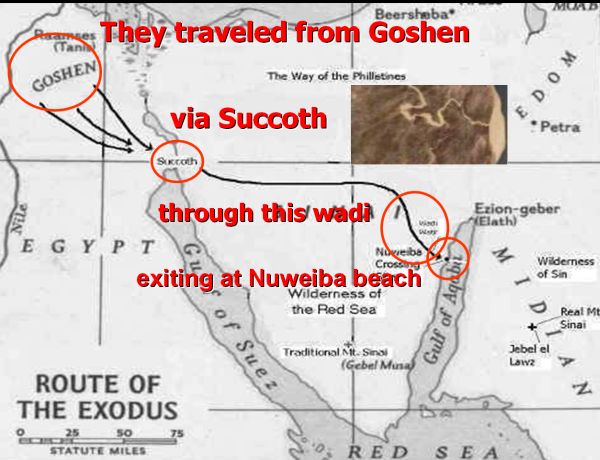
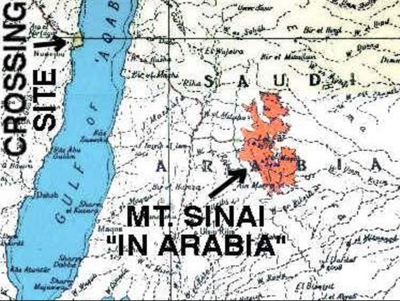

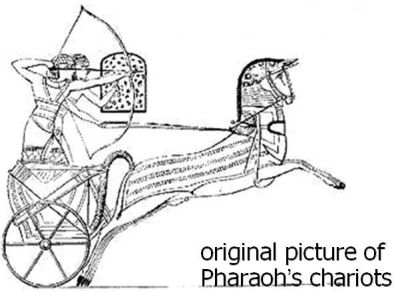
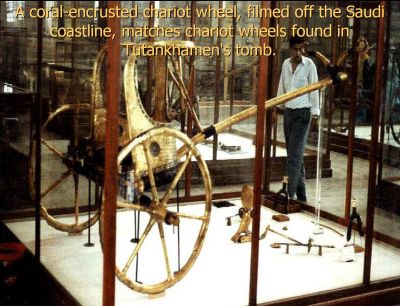
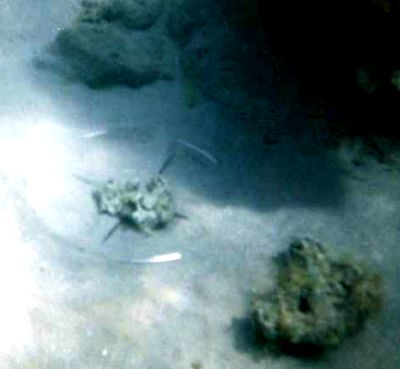

Coral does
not grow on gold, hence the shape has remained distinct.
The wood inside the gold veneer
has disintegrated
making the wheels too fragile
to move. Also on the Arabian side of the crossing were found remains including
the golden calf.(Exodus
32:1-8), pillars and altars. Also were found chariot bodies,
human and horse bones at both the entry point and on the exit side, the
Saudi coastline.



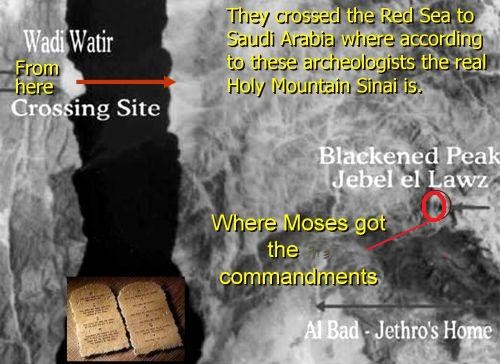
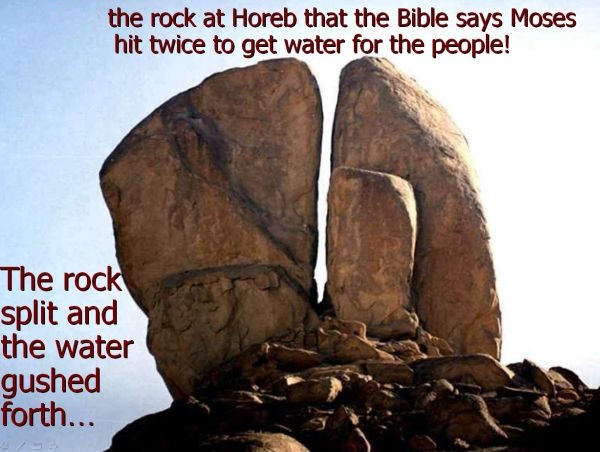
...